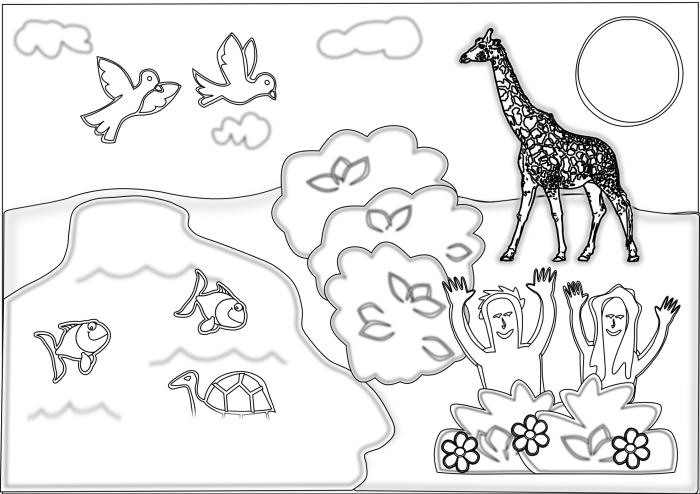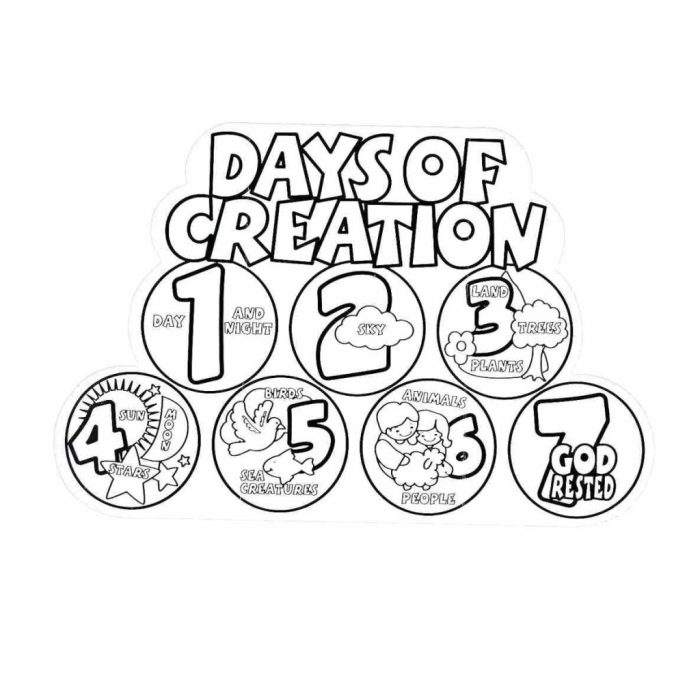Educational Value of “God Created Animals” Coloring Books

God created animals coloring – Coloring books themed around “God Created Animals” offer a unique opportunity to combine creativity with faith-based learning, providing a valuable educational experience for young children. Beyond the simple act of coloring, these books can effectively introduce children to the diverse world of animals and their environments, fostering a deeper understanding of nature and the role of faith in understanding creation.Coloring pages can effectively teach children about animal characteristics and habitats by visually representing key features.
For example, a coloring page depicting a lion could highlight its mane, powerful claws, and tawny coloring. Accompanying text or labels could then identify these features and explain their purpose in the lion’s survival. Similarly, a habitat scene depicting a polar bear in its icy Arctic environment visually reinforces the connection between animal and environment. Through repeated exposure to such visuals, children begin to internalize these characteristics and their ecological significance.
Examples of Educational Coloring Pages
A well-designed coloring page featuring a giraffe might include labels pointing to its long neck, spotted coat, and long legs, along with a short fact about its height or diet. Another page could illustrate a rainforest habitat with several animals, each labeled with its name and a brief description. A more advanced page might include a simple diagram illustrating the food chain within a specific ecosystem, showing how different animals interact.
God created animals coloring pages offer a delightful way for children to explore the diversity of the animal kingdom. However, a subset of these magnificent creatures presents unique challenges, prompting the creation of resources like this collection of dangerous animals for coloring pages, which can be a fascinating and educational addition to any child’s creative pursuits.
Returning to the broader theme, God’s creation encompasses both the gentle and the formidable, making coloring a diverse range of animals a rewarding experience.
For instance, a page might depict a simple food chain: grass → zebra → lion, with labels and brief descriptions for each element. Another page might showcase the different types of beaks birds possess and how those beaks relate to their respective diets (e.g., a woodpecker’s strong beak for pecking wood, a hummingbird’s long beak for sipping nectar).
Benefits in Early Childhood Education
The use of “God Created Animals” coloring books in early childhood education settings offers several advantages. Visual learning is particularly effective for young children, and these coloring books cater to this learning style. The act of coloring itself enhances fine motor skills and hand-eye coordination. Furthermore, the inclusion of factual information and engaging illustrations makes learning about animals fun and accessible, fostering a positive attitude towards nature and science.
The faith-based context can also contribute to the development of spiritual understanding and appreciation for God’s creation. Finally, these coloring books can serve as a springboard for further discussions about animal conservation and environmental stewardship, promoting a sense of responsibility towards the natural world.
Artistic Styles and Techniques in “God Created Animals” Coloring Books

Coloring books depicting God’s creation of animals offer a diverse range of artistic styles, appealing to various age groups and artistic preferences. The choice of style significantly impacts the overall aesthetic and the coloring experience. From simple line drawings to intricate watercolor renderings, these books cater to different skill levels and artistic inclinations.
The artistic styles employed in these coloring books range widely. Simple line art, often found in books for younger children, features bold Artikels and minimal detail, making them easy to color within the lines. More complex designs incorporate elements of pencil sketching, showing shading and texture to create a more realistic or stylized depiction of the animals. Watercolor-inspired styles often feature softer lines and a greater emphasis on color blending, creating a more painterly effect.
Some books even integrate elements of other styles, such as folk art or geometric patterns, resulting in unique and visually engaging designs.
Color Palettes and Their Aesthetic Impact, God created animals coloring
The selection of color palettes plays a crucial role in shaping the mood and aesthetic of a “God Created Animals” coloring book. Vibrant, saturated colors can create a joyful and energetic feel, suitable for younger children. Conversely, more muted or pastel palettes can evoke a sense of calm and tranquility, appealing to older audiences. The use of analogous colors (colors next to each other on the color wheel) can create a harmonious and cohesive look, while complementary colors (colors opposite each other on the color wheel) can provide a more dynamic and contrasting effect.
For example, a coloring page featuring a lion might use warm oranges and yellows to depict its mane, while cooler blues and greens might be used for the surrounding foliage. This strategic use of color enhances the overall visual appeal and allows for creative expression through coloring.
Suggestions for Artists Designing “God Created Animals” Coloring Books
Effective design requires careful consideration of several key elements. Line weight, for example, should vary depending on the age group and the desired level of detail. Thicker lines are better suited for younger children, providing clear boundaries for coloring. Thinner lines allow for more intricate designs and shading, appealing to older children and adults. The level of detail should also be adjusted based on the target audience.
Simpler designs with fewer details are ideal for younger children, while more complex designs with intricate patterns and textures are more appropriate for older children and adults. Finally, composition is crucial for creating visually appealing pages. Consider the placement of animals within the frame, the use of negative space, and the overall balance of the design. A well-composed page is more engaging and encourages creative coloring.
For instance, a symmetrical arrangement might be suitable for a page featuring a pair of birds, while an asymmetrical arrangement might work better for a scene with multiple animals interacting.
Creating a “God Created Animals” Coloring Page: God Created Animals Coloring

Designing a “God Created Animals” coloring page involves careful consideration of animal selection, composition, and line art style to create an engaging and educational experience. The goal is to produce a visually appealing page that inspires creativity while subtly conveying the wonder of God’s creation.This section details the process of creating a simple yet professional-looking coloring page, from initial sketch to final line art, and Artikels the necessary materials.
We will focus on three animals inhabiting diverse habitats to showcase variety and highlight the beauty of God’s creation across different environments.
Animal Selection and Composition
For this coloring page, we’ll feature a polar bear (Arctic habitat), a lion (African savanna habitat), and a brightly colored macaw (tropical rainforest habitat). This selection provides a diverse representation of animal life and their respective environments. The composition will arrange the animals in a visually pleasing manner, avoiding overcrowding while ensuring each animal is prominently featured. The polar bear might be depicted on a simple ice floe, the lion resting beneath an acacia tree, and the macaw perched on a vibrant branch laden with fruit.
This arrangement offers distinct visual cues for each habitat.
Sketching the Coloring Page
The initial sketch is crucial. Using a light pencil (like a 2H or HB), begin by lightly sketching the basic shapes of each animal. Focus on capturing their essential forms and proportions. Pay attention to the relative sizes of the animals to maintain visual harmony. Next, add details such as facial features, fur texture (for the bear and lion), and feathers (for the macaw).
Remember to sketch lightly so that pencil lines can be easily erased if necessary. Finally, sketch in the background elements – the ice floe, acacia tree, and branch – keeping them simple yet evocative of the respective habitats.
Creating the Line Art
Once the sketch is complete and satisfactory, it’s time to create the final line art. Using a fineliner pen or a brush pen with black ink, carefully trace over the pencil lines. For a professional look, ensure clean, consistent lines. Vary line weight to add depth and dimension to the animals and background elements; thicker lines can be used for Artikels, while thinner lines can be used for details.
Once the ink is dry, carefully erase the pencil sketch. This will leave you with a clean, crisp line drawing ready for coloring.
Materials and Tools
Creating a professional-looking coloring page requires the right tools. These include:
- High-quality drawing paper: This ensures the paper can handle both pencil and ink without smudging or tearing.
- Light pencil (2H or HB): For sketching and light Artikels.
- Fineliner pens or brush pens with black ink: For creating the final line art. Different pen sizes allow for varied line weights.
- Eraser: For removing pencil marks.
- Ruler (optional): For creating straight lines, if needed for background elements.
- Sharpener: To keep pencils and pens sharp for precise lines.
Using these materials ensures a clean and professional finish, making the coloring page visually appealing and enjoyable for children to use. The choice of paper is particularly important, as it impacts the overall coloring experience. A heavier weight paper will resist tearing and allow for layering of colored pencils or markers without bleeding.
